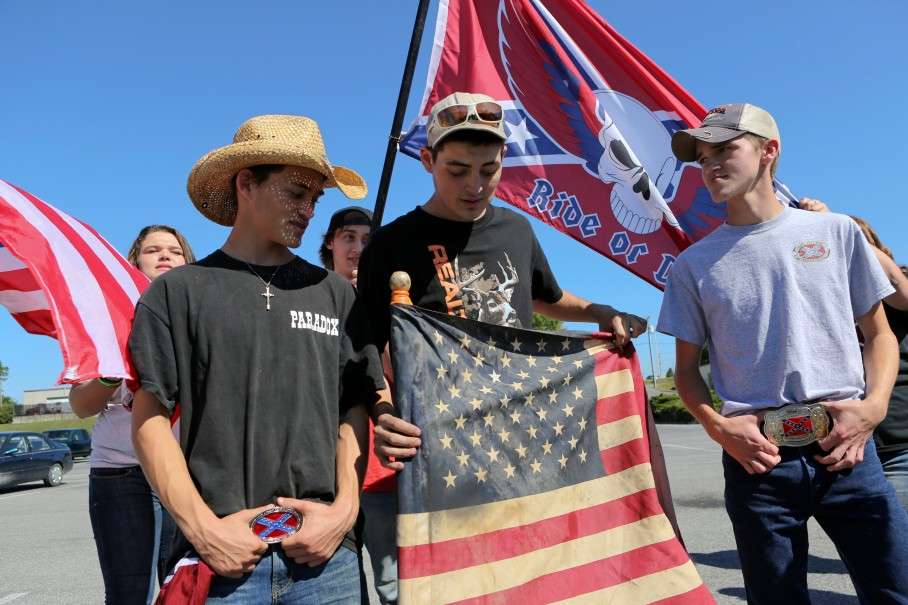The Volokh Conspiracy
Mostly law professors | Sometimes contrarian | Often libertarian | Always independent
The Confederate flag, the First Amendment and public schools

A Friday Post article (by T. Rees Shapiro and Moriah Balingit) reported on the latest Confederate flag controversy:
A peaceful student demonstration at a Virginia high school ended with school administrators suspending 23 teens for wearing clothing emblazoned with the Confederate battle flag, which violates the school's dress code, according to school officials, students and parents.
The students, who attend Christiansburg High School in southwestern Virginia, said they wore the controversial Confederate symbols to protest a school policy that prohibits them, which they view as a violation of their free speech. Students are barred from wearing any clothing that could "reflect adversely on persons due to race" and specifies that "clothing with Confederate flag symbols" falls in that category.
A few thoughts on how courts have handled such matters in recent decades:
1. Nearly all cases have upheld such restrictions, under Tinker v. Des Moines Indep. School. Dist. (1969), because they concluded that there was enough evidence—based on the schools' or neighboring schools' concrete recent experiences—that the display of the flag was likely to materially disrupt schoolwork, by exacerbating racial hostilities and thus leading to fights and similar disruptions.
2. One case, Castorina ex rel. Rewt v. Madison County School Bd. (6th Cir. 2000), sent the case back down to trial court to determine whether there was real evidence of likely material disruption, and whether the school had selectively targeted Confederate flag shirts but not other racially linked and potentially disruptive shirts (the example there was Malcolm X shirts).
3. A few of the cases have taken the view that Confederate flag shirts can be punished on the grounds that they are "plainly offensive" and thus similar to the vulgar speech that schools can punish under Bethel School Dist. No. 403 v. Fraser (1986).
4. One case takes the view that there is essentially a First Amendment exception—quite apart from the general disruptive-speech rule in Tinker—for "racially hostile or contemptuous speech" in schools.
My view is that Confederate flag displays, which convey a political message (though the meaning of which, of course, is contested), can't be judged under Fraser. The court in Fraser specifically distinguished Tinker on the grounds that the speech Tinker—the display of black armbands protesting the Vietnam War—was "political." The court in Morse v. Frederick (2007) noted that "[Fraser] should not be read to encompass any speech that could fit under some definition of 'offensive.' After all, much political and religious speech might be perceived as offensive to some." And the concurrence in Morse by Justices Alito and Kennedy (both of whose votes were necessary to form the five-Justice majority) described Fraser as involving "speech that is delivered in a lewd or vulgar manner," and stressed the general protection for "speech that can plausibly be interpreted as commenting on any political or social issue."
Likewise, I think, as I've argued elsewhere, that there can be no "racially hostile or contemptuous speech" First Amendment exception, even limited to schools. First Amendment precedents preclude there being such an overtly viewpoint-based First Amendment doctrine.
But the Tinker argument is much stronger, if there really is evidence that the Confederate clothing will lead to material disruption (as I expect it often would). At that point, the question is whether one thinks the "heckler's veto" doctrine should apply to K-12 schools. Under that doctrine, government officials generally can't stop speech in public places based just on a fear (even a reasonable fear) that the speech will lead to violent attacks on the speaker, at least unless an outright riot is looming. If one thinks this doctrine carries over to K-12 schools, then such fear of people trying to fight the speaker shouldn't count for Tinker purposes. But if one thinks that the doctrine doesn't carry over to K-12 schools, and that school administrators should be free to prevent substantial risks of material disruption whatever the disruptive mechanism might be, then Confederate clothing would indeed generally be restrictable.
To get the Volokh Conspiracy Daily e-mail, please sign up here.


Show Comments (0)